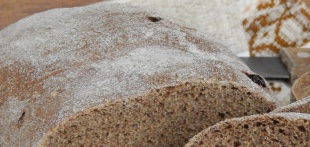



Homemade Karelian bread with raisins is an amazing pastry that you can fall in love with the first time and forever. If you like Borodino bread with its characteristic pleasant sweetness, rich aroma of coriander and rye malt, you will definitely like Karelian bread. It is not difficult to do, although you have to be patient - it will take about 10 hours to cook.
The Karelian bread recipe provides for a sponge preparation method using a special brew. It is thanks to this very infusion that the finished baked goods are distinguished by their characteristic sweetish taste and rich rye aroma.
The dough for Karelian bread contains two types of flour: wheat and rye (seeded). Wheat flour is needed of the second grade, but today it is not at all easy to get it - even in spite of the fact that it is low-grade flour and should be cheap. I found a way out: I just make a mixture of first-grade wheat and wheat whole grain in a ratio of 2 to 1. That is, to get 425 grams of second-grade wheat flour required for the Karelian bread recipe, I mix 300 grams of first grade and 125 grams of whole grain.

Homemade Karelian bread with raisins is an amazing pastry that you can fall in love with the first time and forever. If you like Borodino bread with its characteristic pleasant sweetness, rich aroma of coriander and rye malt, you will definitely like Karelian bread. It is not difficult to do, although you have to be patient - it will take about 10 hours to cook.
The Karelian bread recipe provides for a sponge preparation method using a special brew. It is thanks to this very infusion that the finished baked goods are distinguished by their characteristic sweetish taste and rich rye aroma.
The dough for Karelian bread contains two types of flour: wheat and rye (seeded). Wheat flour is needed of the second grade, but today it is not at all easy to get it - even in spite of the fact that it is low-grade flour and should be cheap. I found a way out: I just make a mixture of first-grade wheat and wheat whole grain in a ratio of 2 to 1. That is, to get 425 grams of second-grade wheat flour required for the Karelian bread recipe, I mix 300 grams of first grade and 125 grams of whole grain.
Sign up to receive email updates on new recipes.